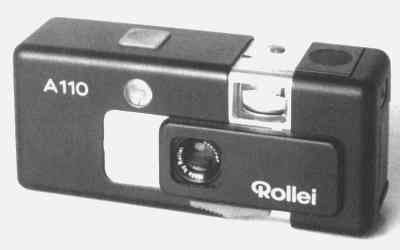
ROLLEI 110 CAMERAS

Fortunately, the Rollei A110 & E110 cameras can use single-perf,
double-perf, or unperforated film in reloaded into 110 cassettes with these
caveats:
With the later Pocketline 110 cameras -- 100, 200, and 300 -- the 110
perforations are needed to cock the shutter, but these cameras can be used
with perforated film if the perforations are placed on the shutter cocking
side -- and if the film is advanced as with double perforated film.
(1974) Excellent, fast 23mm (f2.8-16.0), (4/3) scale-focusing Tessar lens with close-focusing to 3.3 feet. Electronic shutter with speeds of 4 seconds - 1/400. Silicone meter provides programmed exposure control with the camera selecting the most suitable combination of aperture and shutter speed. The cameras had no body serial numbers, but the lenses were numbered. Dimensions:1.75 x 3.3 x 1.2 inches (44x84x30mm). Weight: 6 1/2 oz (185 g) -- with battery. Film wind operation is by push-pull film wind, so there is no film wind lever on this camera. Computer controlled flash system, test button with dual indication for time and normal exposure. In the bight-frame finder on this camera, a green signal is indicated, which shows a correct exposure and the battery remainings. Tripod socket. This is truly a quality camera for a film type normally used in inexpensive plastic cameras. Still, one wonders just how much money people would pay for a 110! The Rollei A110 was priced initially at $300. One does have to focus the camera, however, using a zone sytem with little pictures of people and mountains in the upper part of the viewfinder. Most of the cameras have a satin black finish, but some were made in brushed chrome. Although the results were excellent, the camera can only use 100 speed film, and had a reputation as being mechanically unreliable. Uses one PX27 battery.
Some models of the A110 can be found with a golden finish and an "atom" symbol on the front. This was a promotional model made for the Otto Shipping Company, and about 5,000 units were produced.
It's a Rollei A110 by another name -- but simply a "Thank You" from the German Bitter car modification company with a nice color scheme, for sure. Only about 160 Bitter A110s were produced, and are marked "Rollei A110" on one end.
(1976) Although the Rollei A110 was a quality camera, it was very expensive for a 110 camera. To boost sales a slightly simpler and less-expensive version of the A110 was introduced -- the E110. It had the same lens -- 23mm (f2.8-16.0), (4/3) scale-focusing Tessar lens. The electronic shutter speeds were changed to 4 seconds - 1/250. The silicon meter was replaced with a CDS meter, but still provides programmed exposure control. Size and weight stayed the same. In addition, there is an automatic film feeler to set film speeds from the cassette -- 100 or 400. Tripod socket. This camera is less common and usually found in brushed chrome, while its predecessor, the A110, is usually found in black. Although the results were excellent, like the A110 the camera had a reputation as being mechanically unreliable. Uses one PX27 battery.
(1977) Simple, fixed-focus 26mm f8 Lumetar lens with a single speed of 1/125, but surprisingly it has both cable release and tripod sockets, and a standard hot shoe on one end. Rollei Pocketline flash uses two AA batteries.
(1977) A step up! Fixed-focus 26mm f5.6 Lumetar lens. It still has only a single speed of 1/125, but now two aperture settings -- f9 for sunlight, and f5.6 for low-light or flash. It has both cable release and tripod sockets. Standard hot shoe on one end. Rollei Pocketline flash uses two AA batteries.
(1977) A side-step! A wider, fixed-focus 24.5mm f11 Lumetar lens, but a tele lens can be slid in. Single speed of 1/100. It has both cable release and tripod sockets. Standard hot shoe on one end. Rollei Pocketline flash uses two AA batteries.

To return to the main index for the Sub Club click here.
COPYRIGHT @ 1995-2020 by Joe McGloin. All Rights Reserved.